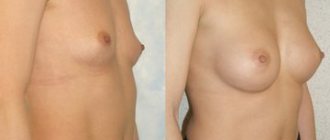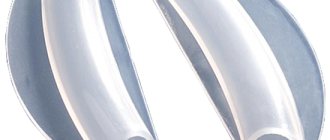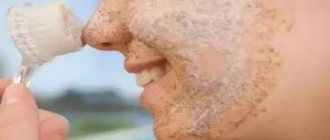When to do it
First of all, the question of the need to re-correct the breasts arises with the desire to change the shape of the breasts or enlarge the breasts larger.
In this case, the indications for this type of operation are not always objective. Here the matter depends on the surgeon himself and his attitude towards his work.
If a specialist in this industry sees that the parameters are met, that is, the volume of the bust corresponds to the figure, the operation was performed correctly without any complications, the surgeon may refuse to perform repeated plastic surgery.
Further, it all depends on the patient - she can listen to the advice of a plastic surgeon, or she has the right to turn to another plastic surgeon for re-plasty.
Another question is due to the fact that the result of breast surgery really leaves much to be desired.
This is due to various factors, such as asymmetry, too much volume, sagging breasts, then a woman’s desire to undergo repeated plastic surgery is correct and quite logical.
If the question “When should repeat mammoplasty be done?” - includes time, then you should know that repeated breast correction should be done no earlier than six months after the first operation.
Factors affecting nipple sensitivity after breast augmentation
- Implant insertion site
. Mainly axillary, submammary and periareolar approaches are used. When a graft is introduced through an areola incision, nerve patency is often disrupted. Numbness of the stitches may be observed for six months, then the sensation returns. This is due to injury to areas of nerves that are subsequently restored. - Graft size
. Nipple sensitivity may also increase after breast augmentation. The reason is that the implants are too large and exert too much pressure. It takes time to restore familiar sensations. - Repeated correction
. Removing the implant entails damage to the surrounding structures, which can lead to temporary loss of sensitivity. - Removal of part of the gland for tumor diseases
. Not only the gland, but also nearby nerve endings are involved in the oncological process. As a result of the reduction, numbness is noted.
Why is it needed?
Mostly women who have undergone breast augmentation seek revision breast surgery.
There is a list of factors why repeated mammary surgery is needed; let’s consider some of them:
- The endoprosthesis chosen is too large. With breast augmentation, the patient strives for very large sizes and is confident in her desire. Of course, the plastic surgeon will not refuse and will make the breasts large, but the larger the breasts, the higher the risk of postoperative complications and breast sagging. A large implant contributes to further tissue thinning and rupture, which can subsequently lead to implant loss.
- The plane for installing the implant is incorrectly selected. In this case, everything depends on the experience of the plastic surgeon. For the correct location of the implant, there are a number of small details that need to be taken into account when choosing, including the individual characteristics of each patient, body structure and skin structure. This operation is necessary and necessary in order to correctly place the implant.
Photo: Implants
Consequences of mammoplasty
Plastic surgeries often lead to necrosis of the skin. As a result of gravity, the implant exerts strong pressure directly on the skin of the mammary glands. Blood supply is disrupted and necrosis occurs. The process can last 2–3 months, or it can last up to 5 years. The consequences of breast augmentation can be eliminated through additional surgery and insertion of an implant under the pectoral muscle.
When breasts are enlarged through plastic surgery, the nipples may lose sensitivity. This is due to the fact that a nerve was affected during the operation. Often sensitivity is restored after some time.
Complications after breast augmentation occur when sensitivity is not restored for a long time or when a woman has had her breasts enlarged, hypersensitivity appears that was not there before.
Women are worried about the possible consequences affecting the areola area.
These mainly include the following violations:
- changes in nerve conduction;
- inflammation and swelling;
- difficulties with breastfeeding.
Indications
For re-operation the following indications:
- Capsular contracture is the formation of a dense scar around the implant. This deficiency can contribute to lumps in the breasts, which can lead to painful sensations in the breast area and deformed breasts. In the process of capsular contracture, the following are formed:
- seroma;
- purulent-inflammatory processes;
- bleeding.
Seroma is an accumulation of lymphatic fluid in the tissues. It occurs when a plastic surgeon performs operations at double speed, without following the correct technique, and contributes to the formation of seromas.
- Leakage of solution from the saline implant. This most often occurs due to an incorrectly selected implant or an incompletely filled prosthesis, which results in thinning of the walls of the prosthesis and penetration of fluid into the tissue. This factor threatens the life and health of the patient.
There may also be indications for repeat breast surgery such as:
- implant displacement;
- loss of breast shape associated with changes in weight, weight loss or, conversely, weight gain;
- change in breast volume after pregnancy and breastfeeding.
Possible complications associated with implants
A capsule is formed around the breast implant. Capsular contracture is more common with silicone implants. Capsular contracture, consisting of fibrous tissue, begins to compact the implant, which leads to pain. The aesthetic appearance of the breast also deteriorates.
Surgery for severe capsular contracture allows removal of the capsule itself and the endoprosthesis. Mild cases do not require surgery.
Implant rupture
High quality implants undergo many stages of testing at factories, which indicates their safety. They are filled with state-of-the-art cohesive gel and come with a lifetime warranty. Even if the implant ruptures, the gel will not leak into the soft tissues and will not harm the patient’s health.
Dangers of revision mammoplasty
For successful revision breast surgery, you need to choose an experienced specialist and listen to the recommendations.
When performing post-operative mammoplasty, it is worth knowing that all consultations and tests, visits to doctors, all these actions need to be done again, which affects the general physical condition and can lead to psychological breakdowns and nervous disorders of the woman.
Therefore, before re-correcting your breasts, think about it, maybe the first result is not so bad...
How to do it
The operation is carried out at the clinic with a further stay in the hospital. As a rule, it is performed under general anesthesia.
This operation has several stages:
- removal of the prosthesis - the doctor makes an incision along the line of scar tissue and removes the implant;
- capsulotomy partially or completely excises the entire scar membrane with the application of clearer, thin and neat sutures;
- installation of a new prosthesis - if the implant is the same size as the previous one, it is installed in the old place, but if the new implant is larger or smaller, then the doctor forms a new location for such an implant.
It is also worth knowing about the incisions that will be made during the operation. The cuts depend on the number of changes made.
When replacing a prosthesis or capsular surgery, an incision may be made along an existing suture. If you need to tighten your breasts, incisions are made to tighten them.
The first incision is made around the areola, in the case of a minor breast lift. In the case of a large lift and tension, another incision is made, vertical, from the lower edge of the areola to the inframammary fold.
The third incision is made horizontally, along the lower semicircle, while the nipples and areola are not separated from the tissue and remain sensitive and capable of breastfeeding.
After plastic surgery is completed, the surgeon stitches the incisions and applies a sterile dressing. The operation lasts from one and a half to two and a half hours.
After the operation, the patient is transferred to a hospital, where she can stay from a day to several hours, depending on her general condition.
A few hours after the operation, you are allowed to walk. The bandage is removed a few days after the operation. You need to wear shapewear for several days.
The sutures are removed approximately ten days after surgery.
The recovery period lasts a little longer than after the first breast correction. It is important to follow all the doctor’s recommendations, maintain contact with him and go to all necessary consultations.
How to avoid
- the first month after mammoplasty, you must wear a compression bra, treat the sutures with ointments and gels prescribed by the doctor;
- For at least 21 days after surgery, you should not lift heavy objects, bend over sharply, or sleep on your stomach. You can raise your hands no earlier than 7-10 days;
- during the rehabilitation period, visiting the beach, bathhouse, solarium, swimming pool is excluded, and sports are prohibited;
- At the first signs of an inflammatory process in the chest, you must immediately consult a doctor.
Complications
Complications after repeated breast surgery should be divided into two groups:
- general surgical complications;
- specific complications.
General surgical procedures include:
- wound infection;
- formation of hypertrophic scars;
- hematoma;
- increased temperature after repeated plastic surgery;
Specific complications include:
- implant rupture;
- deformation of the prosthesis;
- implant displacement:
- double fold;
- calcification;
- allergic reaction to the prosthesis;
- inability to perform mammography;
- symmastia;
Photo: Deformation of the prosthesis.
Implant rupture is a violation of the integrity of the prosthesis, resulting in deformation and sagging of the breast. The breast does not deform immediately, so implant rupture can be detected with magnetic resonance imaging.
Deformation of the prosthesis - looks like stretch marks on the chest and is a complication both during the first operation and during a repeat operation.
Double fold - occurs when the prosthesis is placed incorrectly, and is corrected again with the help of plastic surgery.
Calcification – characterized by the deposition of salts around the prosthesis and looks like lumps around the breast.
An allergic reaction to a prosthesis - does not appear very often and depends on the female body’s perception of the materials from which the prosthesis is made
Read when you can sleep on your side after mammoplasty. When can you drink alcohol after mammoplasty? The answer is in this article.
Inability to do mammography —Mammography is needed to identify new breast growths, such as lumps, that need to be removed.
Symmastia - looks like the fusion of two breasts; it can appear due to too close proximity of the mammary glands and a large volume of selected prostheses.
Complications and solutions
In some cases, a woman notices that the implant in the breast is not positioned correctly or that any movement of the body brings unbearable pain.
If discomfort occurs, it is important to consult a specialist in a timely manner in order to immediately begin treatment, if necessary.
Swelling
With normal recovery of the body, swelling disappears 3-5 days after surgery. This is the maximum period during which excessive hyperemia and tissue swelling should pass.
Edema is pathological if:
- there was a feeling of fullness;
- the skin around the chest is very red;
- local low-grade fever (skin is hot to the touch);
- body temperature increased;
- pain is not relieved by analgesics.
If such signs appear, you should urgently consult a doctor.
Excessive swelling is eliminated by physiotherapy and the application of cooling compresses in a hospital setting. It is not recommended to treat swelling on your own. If the pathology is accompanied by the formation of pus under the implant, surgical treatment is prescribed.
Seroma
Seroma is the accumulation of lymphatic fluid in the subcutaneous fat. Such a complication can be caused by incorrect actions of the surgeon during surgery, implants that are too large for a certain breast, or non-anatomical tissue dissection.
When to suspect a seroma:
- the chest is very swollen;
- clear liquid is released from the unhealed scar of the swollen mammary gland;
- the pain is constant;
- the scar turned very red.
Dangerous hematomas
A hematoma is an ordinary bruise, that is, subcutaneous hemorrhage. It can appear due to injury to the unrecovered breast, improper stopping of bleeding during implant installation, and unqualified actions of medical personnel during the rehabilitation period.
Minor bruising is normal and will resolve on its own. But in some cases, medical attention is required.
When consultation is needed:
- the hematoma is very extensive, it can spread under the chest or into the shoulder area;
- the symptom is accompanied by an increase in body temperature;
- the pain does not go away a week after the operation.
The first thing you need to do is stop the bleeding. To do this, the specialist uses hemostatic agents, medications to lower blood pressure (if necessary) and the application of ice compresses.
In the future, extensive hematoma must be removed using tissue drainage.
Breast sagging
Sometimes sagging occurs long after surgery, as a natural process of tissue aging. But if we talk about complications, ptosis should be mentioned.
It can be artificial and pronounced. In the first case, sagging occurs due to the installed implant being too small; in the second, tissue sagging is a feature of the body and its reaction to a foreign body.
How to determine ptosis:
- nipples are located above the average level of the chest;
- the mammary glands are strongly drooping;
- The distance between the collarbones and the beginning of the chest has increased.
Implant contouring
This complication most often develops in those women who have too thin a layer of subcutaneous fat. When the implant is installed not under the muscle, but directly under the mammary gland, its contours can be visible through the surface of the epidermis.
How to determine contouring:
- the contours of the implant can be seen visually and palpated;
- the chest protrudes unnaturally.
To eliminate this complication, the specialist will suggest the introduction of special corrective fillers. In some cases, lipofilling is indicated.
This procedure involves taking sebum from suitable areas on the patient's body and then transplanting it into the chest area.
Implant displacement
Implant displacement is another unpleasant complication after mammoplasty. Most often it develops due to incorrect selection of an endoprosthesis or illiterate actions of the plastic surgeon during surgery.
How to determine offset:
- the implant protrudes unnaturally to the side from its main position;
- The mammary glands look asymmetrical.
In the early stages, you can correct the situation by wearing a special corrective corset and a certain position of the body while sleeping. Also, when the implant is displaced, all physical activity is temporarily eliminated.
Inflammation, suppuration
One of the most dangerous complications is suppuration of the postoperative suture. This can happen due to non-compliance with the rules of asepsis and antisepsis during surgery, the patient’s failure to follow the doctor’s recommendations, and improper treatment of the scar.
How does the complication manifest itself?
- the chest is very swollen and burning;
- in a short time the body temperature rises to high levels;
- the skin around the mammary gland turns red;
- pus is separated from the suture or nipple itself.
In the initial stages, inflammation can be stopped by taking antibacterial agents and intensive treatment of inflamed skin.
Loss of sensation
During the first time after an incision in the skin, it loses its sensitivity. This is not a pathology and can be quickly eliminated with the help of physiotherapy.
But sometimes the patient does not feel the breast tissue or the nipple itself for a long time. This complication occurs due to incorrect actions of the surgeon during mammoplasty, which can damage the nerve network.
To combat the problem, the specialist prescribes a complex of physiotherapy and massage.
Capsular contracture
After installing the implant in the mammary gland, connective tissue begins to form around it. In a normal state, it does not exceed a tenth of a millimeter and the growth stops there .
But due to the characteristics of the body, this process can progress, which provokes the formation of capsular contracture.
How to determine a complication:
- the endoprosthesis and its contours can be felt by hand;
- breast deformation occurs;
- seals, dents or defects appear on the mammary gland;
- when touched, the patient feels pain.
The second stage of capsular contracture is eliminated with the help of physiotherapy, massage, the use of vitamin E and a complex of anti-inflammatory injections.
Stages 3 and 4 can only be corrected surgically. To do this, the specialist completely removes the implant, removes the contracture and installs it again. Sometimes a smaller endoprosthesis is selected.
Rippling or skin ripples
Rippling, also called skin rippling, is a fairly rare complication after mammoplasty. This can happen due to the characteristics of the patient’s body, the incorrectly selected type and size of the implant, as well as the illiterate actions of the surgeon.
How to determine the appearance of skin ripples:
- predominantly, the defect is noticeable when the body is tilted forward;
- peculiar folds appear on the skin of the chest, similar to fingerprints.
Most often, breast lipolifting is used to eliminate the defect. In some cases, a specialist may recommend replacing the implant with an endoprosthesis with a denser structure.
Approximate cost
Prices for repeated breast surgery, given that it is no less complex than the first plastic surgery, are also not cheap and depend on the methods and quality of the operation.
Conventionally, repeated breast correction should be divided into several types and then decide on the cost of the operation.
- removal of breast implants – from RUB 100,000. up to 250,000 rubles;
- replacement of breast prostheses – from 240,000 rubles. up to 350,000 rub.;
- treatment of capsular contracture - from 200,000 rub. – up to 330,000 rub..
Answers to frequently asked questions
Why do women have to undergo breast surgery again after breast augmentation?
Answering this question, there is no clear answer to it. There are many factors that force a woman to seek revision surgery.
Many women, due to intensive weight loss and constant dieting, lose weight, and this contributes to a decrease in fatty tissue, displacement of the prosthesis and further sagging of the breasts.
Many women also undergo breast augmentation to reduce scarring after their first surgery.
Do scars actually disappear or not?
Unfortunately no, the scars remain. But sometimes they are completely invisible; it all depends on the technique the doctor uses and how the process of healing wounds on the woman’s body goes.
How is the rehabilitation period going and do you need to adhere to any restrictions after plastic surgery?
The rehabilitation period is the same as after the first operation. It is necessary to follow the doctor’s recommendations, monitor your diet, wear shapewear, bandages, and bandages.
Often, repeated plastic surgery is resorted to if the rules of rehabilitation after the first plastic surgery were not followed in the first one.
See how to massage after mammoplasty. What is vertical mammoplasty? Find out here. When can you sunbathe in a solarium after mammoplasty? Read on.
Can breast correction lead to cancer?
No, there can be no cancer as a result of breast surgery or repeated breast surgery.
Since this section of surgery is now widespread and the best specialists work in this industry, the risk of tumors in the breast is reduced to a minimum.
How often do dentures need to be replaced?
Manufacturers provide a lifetime guarantee for their product, but there are always a number of cases when implants do not meet the quality or prostheses are not suitable for a woman due to the individual characteristics of the female body.
To be sure of the quality of the prostheses you choose, consult with manufacturers and experts in the industry..
Does plastic surgery affect the ability to breastfeed?
You can breastfeed without any worries and you can plan a pregnancy two to three months after the second operation.
It is impossible to predict how the breasts will behave after breastfeeding.
For many women, the breasts sit back on the implant and no additional corrections are required, but for some, on the contrary, the breasts sag and require additional surgical intervention and a small breast lift.
How to choose the right plastic surgeon?
The question is very relevant, since there are many, many surgeons in this field. If, for example, you are not satisfied with the specialist who performed your first plastic surgery, you should turn to another one.
There are many good specialists and no less unscrupulous specialists.
Pay attention to the doctor’s practice, how many patients the specialist sees per year, and whether they are satisfied with the results of the operations performed.
Secondary mammoplasty
Secondary (repeat) mammoplasty is a surgical intervention that is aimed at correcting the mammary glands after unsatisfactory results of previous operations. In addition, this type of plastic surgery is used when it is necessary to replace silicone breast implants in the presence of complications.
The reasons for the unsatisfactory result of previous plastic surgery can be different: from the unprofessionalism of the surgeon to poorly selected implants. Moreover, infection, an individual reaction of the body, or simple non-compliance by the patient with the doctor’s recommendations is possible.
Repeated plastic surgery is possible in most cases. However, it should be understood that this is always a more complex intervention from a technical point of view. In addition, the risk of complications with revision breast surgery is higher than with the initial surgery. These circumstances are explained by the following reasons:
- When performing breast plastic surgery a second time, the doctor has to work with adhesions that have formed in the patient’s tissues and made them less pliable, which complicates surgical intervention;
- Often the surgeon cannot draw up an operation plan in advance because he does not know exactly what was done during the previous plastic surgery.
An important role in achieving a successful result is played by the correct choice of a surgeon who has many years of practice and takes into account the individual characteristics of the patient.
Indications:
- the patient's dissatisfaction with the new size or shape of the breast;
- unaesthetic appearance of the breast;
- the occurrence of asymmetry or allergies after a previous operation;
- displacement, rupture or deformation of implants;
- prolapse of the mammary glands;
- unnatural folds or wrinkles on the skin due to gland atrophy;
- the occurrence of complications after previous mammoplasty.
Contraindications:
- oncology;
- infectious diseases;
- diabetes;
- diseases of the cardiovascular system;
- unstable psychological state of the patient;
- overweight;
- blood clotting disorder;
- period of lactation and pregnancy;
- mastopathy;
- serious disruption of internal organs;
- phlebeurysm.
Before performing breast surgery again, the doctor examines the patient. The intervention should not be performed earlier than 6 months after the initial operation.
Methods
Re-operation is performed using the same method as primary reconstructive mammoplasty. Access is through the armpit, areola or inframammary fold.
When choosing implants for replacement, the patient’s problems and wishes, as well as the anatomical features of the breast, are taken into account.
Postoperative period and rehabilitation
Recovery of the body after repeated surgery on the mammary glands, including replacement of breast implants, proceeds in the same way as during the primary intervention.
In the first days after plastic surgery, the patient may feel discomfort, moderate pain and skin tension at the site of swelling. These symptoms gradually disappear with rehabilitation. The possibility of bruising and bruising cannot be ruled out. To speed up recovery and reduce the risk of complications, the doctor prescribes additional drug treatment.
In most cases, swelling goes away within the first week. The sutures after repeated surgery are removed after about 5-7 days. However, the duration of the rehabilitation period depends on the individual characteristics of the patient’s body.
To ensure a successful recovery, wearing special compression garments for a month is recommended. It will provide maximum comfort during movements and gradual adaptation of the skin to new forms. Scars obtained during surgery may thicken and turn red during the first months, after which they disappear over time and become invisible.
For comfortable rehabilitation after secondary breast surgery, follow these recommendations:
- limit physical activity and stop playing sports;
- do not visit the bathhouse or solarium;
- do not sunbathe;
- take a shower no earlier than 6 days after plastic surgery;
- Avoid taking a bath until the healing process is complete;
- sleep on your back with your head elevated during the first weeks after plastic surgery;
- do not take blood thinners;
- See your doctor regularly for checkups.
Your doctor will provide you with a complete list of recommendations.
We invite you to familiarize yourself with the ongoing promotions, thanks to which you have a chance to win free breast surgery. To find out more details, follow the link with the offer you are interested in. You will find all the necessary information on secondary mammoplasty, you will be able to study patient reviews, doctor’s comments and see photos before and after the second operation.








